![]()
![]()
![]()
Use LEFT and RIGHT arrow keys to navigate between flashcards;
Use UP and DOWN arrow keys to flip the card;
H to show hint;
A reads text to speech;
64 Cards in this Set
- Front
- Back
|
1. Define Matrix (pg. 136):
|
Surface
In printmaking, the working surface of the block, slab, or screen. In sculpture, a mold or hollow shape used to give form to a material that is inserted in a plastic or molten state. |
|
|
Woodblock (Woodcut); Chinese-made, they used to stamp patterns onto textiles and paper using carved wood blocks.
|
2. What is the oldest form of printmaking? What country? (pg. 136)
|
|
|
In Wood Engravings many thin layers of wood are laminated, then the ends of these sections are planed flat, yielding a hard, non-directional surface, making it relatively easy to work lines in varying directions.
|
3. Woodcuts use the flat surface of the board, what about wood engravings (pg. 138)?
|
|
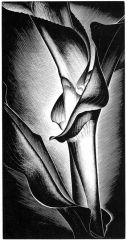
You see fine lines and bottling, he used parallel groupings of thinner and thus lighter lines to render the tonal gradations.
|
4. What is the method of lines in Paul Landacre’s “Growing Corn” (pg. 139)? Know title.
|
|
|
Intaglio
|
5. What types of print are used in metal plates (lines have been incised)?
|
|
|
6. Define Intaglio (pg. 138):
|
A printing process, in which metal plates are incised, covered with ink, wiped, and pressed against paper. The print receives the image of the areas that are below the surface of the matrix.
|
|
|
Engraving
|
7. What type of intaglio uses sharp burin to create clean-cut lines?
|
|
|
8. Define Etching (pg. 140):
|
Acid Bath etches matrix where wax has been removed.
In printmaking, an intaglio process in which the matrix is 1st covered with an acid-resistant ground. The ground is removed from certain areas with a needle, and the matrix is dipped in acid, which eats away at the areas exposed by the needle. These areas become grooves that are inked and printed. |
|
|
9. Define Serigraphy (aka Silkscreen Printing) (pg. 145):
|
Stencils are used to create the design or image, unlike other graphic processes; these images can be rendered in paint as well as ink.
|
|
|
Yes, aquatint with etching mimics wash drawing.
|
10. Can a serigraph use ink and paint?
|
|
|
Lithography (uses stone)
A surface printing process in which an image is drawn onto a matrix with a greasy wax crayon. When dampened, the waxed areas repel water while the material of the matrix absorbs it. Oily ink is then applied, which adheres only to the waxed areas. When the matrix is pressed against paper, the paper receives the image of the crayon. |
11. What is the printing process that uses planographic or surface printing (pg. 144)?
|
|
|
Hung Liu’s “Untitled” 1992
This painting is about when the Communist revolution took hold and all able-bodied individuals were forced into labor, these women were forced into prostitution because the traditions of oppression that led to the practice of binding their feet (thus shrinking them) made them unfit for physical toil, as they could barely walk. |

12. Who did the Chinese painting “Untitled” (pg. 142)? What is it about? Know about painting and history
|
|
|
13. Define Monotype (pg. 146):
|
Yields only a single image (therefore is a unique work of art), and is a printmaking process, which overlaps the other 2-D media of drawing and painting.
In printmaking, a technique in which paint is brushed onto a matrix that is pressed against a sheet of paper, yielding a single print. |
|

Supermodel Icon
|
14. In the painting “Red Coat” what kind of person is Alex Katz portraying (pg. 146)?
|
|
|
Abstraction
|
15. The invention of the camera led to what 20th century art style?
|
|
|
Photographic, because it uses light to produce an image (Photography, comes from the Greek, to write with lights)
|
16. What Greek root is used to write with light? Why light?
|
|
|
Light comes in through a narrow opening; the image is reversed and is projected onto a photosensitive surface.
When the light enters the eye, the lens keeps it in focus by responding automatically to its distance from the object. The light is then projected onto the retina, which consists of cells that are sensitive to light and dark and to color. Nerves transmit visual sensations of objects from the retina to the brain. In the same way, the camera lens focuses light onto a photosensitive surface such as film. A camera lens can be focused manually or automatically. |
17. How are the camera and the human eye alike (pg. 152)?
|
|
|
Fluorescent lights as art
|
18. Dan Flavin creates sculptures out of?
|
|
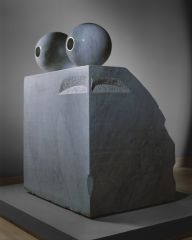
Marble
|
19. What materials did Louise Bourgeois use in his sculpture “Eyes” 1982 (pg. 184)?
|
|
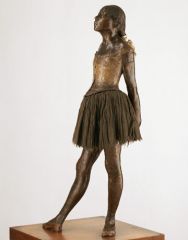
Bronze
|
20. What materials were used in Edgar Degas “Little Dancer, 14 Years Old” (pg. 182)?
|
|
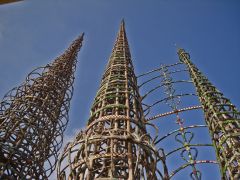
Was made out of debris, such as mirror fragments, broken dishes, shards of glass, ceramic tile, and shells.
|
21. Simon Rodia’s “Simon Rodia Towers in Watts” (1921 - 1954) was created out of what mixed media assemblage (pg. 191)?
|
|
|
It prompts the viewer to think and to think again.
|
22. Marcel Duchamp’s function of a readymade (pg. 190)?
|
|

Alexander Calder “Five Swords” (1976); he also created Mobil’s
|
23. Who did “Five Swords” (1976) (pg. 195)? What other type of metal work did he do?
|
|
|
Candid Shots; Staged – people are doing things.
|
24. What is it called when the shutter opens in quick succession? Why? (pg. 152)
In photography, unposed, informal. The shutter of a camera can be made to remain open to light for various amounts of time, ranging from a few thousandths of a second-in which case _____ shots of fast succession can be taken-to a second or more. |
|
|
Resolution
|
25. What is a higher quality of photograph (pg. 153)?
High-quality digital cameras take photos whose _________, or sharpness, rivals that of images recorded on film, and can be uploaded to a computer. |
|
|
Heliography (Writing with lights); 1826 by the Frenchman Joseph-Nicéphore Niepce
|
26. What is the 1st photo process? When was it invented? (pg. 154)
A photographic process in which bitumen is placed on a pewter plate to create a photosensitive surface that is exposed to the sun. |
|
|
27. Daguerreotype – know process and who (pg. 154)?
|
Louis-Jacques-Mandé Daguerre
A photograph made from a silver-coated copper plate; named after Louis Daguerre, the innovator of the method. |
|

Yosemite National Park, California
|
28. Ansel Adams “Moon Over Half Dome” (1960) where is its location (pg. 150)? (know painting)
|
|
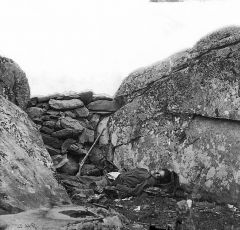
Alexander Gardner “Home of a Rebel Sharpshooter, Gettysburg” (July 1863) was done in the Civil War era; Whatsits, as referred to by the soldiers
|
29. What time period was “Home of a Rebel Sharpshooter, Gettysburg” (July 1863)? Know what artist and painting. What is using a camera in a wagon called (pg. 157)?
|
|

Isolation
The Statues are not portrayed to be talking to each other or interacting, they are at once connected and disconnected, sharing a place and time and yet lost in their inner worlds. |
30. What does George Segal’s “Three Figures Four Benches” (1979) reflect in the people (pg. 183)?
|
|
|
Assemblage
It uses wooden objects with previous lives, such as finials, and also used common objects such as bowling pins, chair slats, and barrel staves, the only 3 colors she used were gold, black and white. |
31. Louise Nevelson found wood lying around to use in her works, what is this process called? Why? (pg. 189)
|
|
|
Able to bend, so it can be shaped.
The degree to which a material can withstand being stretched. |
32. What is tensile strength (pg. 185)?
|
|
|
Wood since it is able to bend and stretch, wood isn’t nearly as likely to break off as stone is.
|
33. Which has more tensile strength – wood or stone?
|
|
|
Welding, Riveting, and Soldering
|
34. What are the direct metal uses in sculpture process (pg. 186)?
Metal has been used for thousands of years and have been cast, extruded, forged, stamped, drilled, filed, and burnished in the past. In recent years, artists have now assembled direct-metal sculptures by _______, ________, and _________. Modern adhesives have now made it possible to glue sections of metal together into 3-D constructions. |
|
|
35. Define Subtractive Process (pg. 181):
|
In sculpture, it is the removal of material, as in carving.
|
|
|
36. Define Additive Process (pg. 181):
|
In sculpture, it is adding or assembling materials, as in modeling and constructing.
|
|

Subtractive Process
|
37. Michelangelo used what to create “The Cross-Legged Captive” (c. 1530-1534) (pg. 181)?
|
|
|
Additive Process
|
38. Modeling, Casting, Constructing, and Welding are what type of sculpture process?
|
|
|
Subtractive Process
|
39. What is the most demanding sculpture process?
|
|

The Great Depression
|
40. Dorothea Lange “Migrant Mother, Nipomo, California” (1936) was taken during (pg. 157)?
|
|
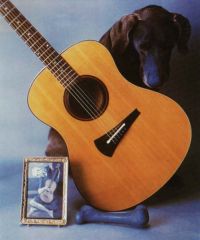
Picasso and his work “Old Guitarist”
In both works, a guitar cuts diagonally across the composition, adding the only contrasting color to the blue background. The heads of the man in Picasso’s painting and the dog in Wegman’s hang soulfully over the guitar(s). Picasso’s gives the man’s flesh a bluish tint, as did Wegman with the dog’s muzzle, which is contrasted by the blue rubber bone. |
41. William Wegman’s “Blue Period” is a canine’s spoof about what artist and work (pg. 161)?
|
|
|
42. Define Montage (pg. 167):
|
In cinematography or video, the use of flashing, whirling, or abruptly alternating images in order to convey connected ideas, suggest the passage of time, or provide an emotional effect.
|
|
|
A Flash, Swirl or Whirl
|
43. A montage of film uses what to show progression of time and events?
|
|
|
Casting, any material that hardens can be used for casting.
|
44. Wax, Concrete, Bronze, Iron, and really any metal or plastic is what in art?
|
|
|
45. Define Casting (pg. 182):
|
The process of creating a form by pouring a liquid material into a mold, allowing it to harden, and then removing the mold.
|
|
|
46. Define Kinetic Art (pg. 191):
|
Moving Art
Art that moves, such as the mobile, which may be caused by the wind, magnetic fields, jets of water, electric motors, variations in the intensity of light, or the active manipulation of the observer. |
|
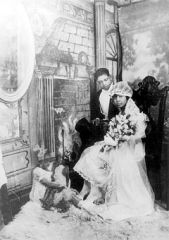
He experimented with painted backgrounds and double-exposed images in otherwise traditional portraits, in order to create drama.
His “Future Expectations” is a visual record of a young couple on their wedding day and a symbol of their hopes and anticipations. A comfortable home with a blazing hearth, and beautiful children, secure in their love. |
47. What did James Vanderzee do in his traditional portraits? His painting “Future Expectations” (1915) is about what (pg. 160)?
|
|
|
48. Define Flashback (pg. 166)?
|
The storyline is interrupted by the portrayal or narrative of an earlier episode.
In cinematography and video, an interruption of the story line with the portrayal of an earlier event. |
|
|
49. Define Flash-Forward (pg. 166)?
|
Glimpses of the future
In cinematography and video, an interruption of the story line with the portrayal of a future event. |
|
|
50. Define Fading (pg. 166)?
|
Used to proceed from 1 scene to another
In cinematography and video, the gradual dimming or brightening of a scene, used as a transition between scenes. |
|
|
51. Define Dissolve (pg. 167)?
|
More rapid and current
In cinematography and video, a fading technique in which the current scene grows dimmer as the subsequent scene grows brighter. |
|
|
52. Define Etching (pg. 140):
|
Acid Bath etches matrix where wax has been removed.
In printmaking, an intaglio process in which the matrix is 1st covered with an acid-resistant ground. The ground is removed from certain areas with a needle, and the matrix is dipped in acid, which eats away at the areas exposed by the needle. These areas become grooves that are inked and printed. |
|
|
53. Define Engraving (pg. 139):
|
Cutting; in printmaking, an intaglio process in which plates of copper, zinc, or steel are cut with a burin and the ink image is pressed onto paper.
|
|
|
Etching uses acid bath, while Engraving does not.
|
54. What is the difference between etching and engraving?
|
|
|
55. Define Soft-Ground Etching (pg. 144)?
|
An etching technique in which a ground of softened wax yields effects similar to those of pencil or crayon drawings.
|
|
|
56. Define Gauffrage (pg. 144)?
|
An inkless intaglio process.
|
|
|
Limestone and water; anything wax based
|
57. Lithography uses what? What attracts the ink?
|
|
|
58. Define Lithography (pg. 144):
|
A surface printing process in which an image is drawn onto a matrix with a greasy wax crayon. When dampened, the waxed areas repel water while the material of the matrix absorbs it. Oily ink is then applied, which adheres only to the waxed areas. When the matrix is pressed against paper, the paper receives the image of the crayon.
|
|
|
Silkscreen, uses stencils, and a different stencil for each color.
|
59. What does Serigraphy use?
|
|
|
60. Define Serigraphy (or Silkscreen Printing) (pg. 145):
|
A printmaking process in which stencils are applied to a screen of silk or similar material stretched on a frame. Paint or ink is forced through the open areas of the stencil onto paper beneath.
|
|
|
61. Define Photo Silkscreen (pg. 146):
|
A variation of Serigraphy, or Silkscreen Printing, that allows the artist to create photographic images on a screen covered with a light-sensitive gel.
|
|
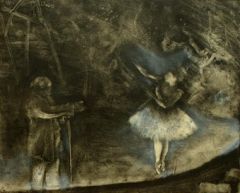
Inked the plate as 1st step.
|
62. In Edgar Degas “The Ballet Master” (c. 1874), what was the 1st step (pg. 147)?
|
|
|
Limited number of prints, 5/15 – 5 out of 15; A/P – Artists’ Proof (1 of a kind)
|
63. What is a Limited Edition?
|
|
|
1 of a kind pieces which are signed in pencil.
|
64. What are Artists Proofs?
|

